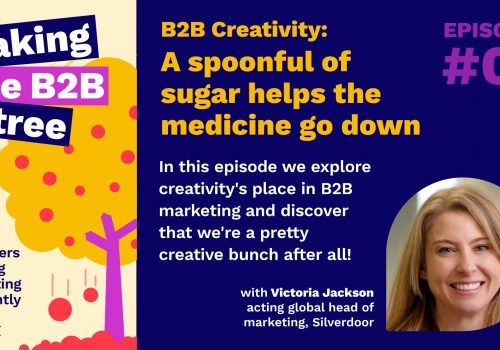Continuing our series of B2B marketing expert inteviews, I recently caught up with Ruth Connor, group marketing director at Kalibrate. Ruth is a strong proponent of customer base marketing which she feels is often overshadowed by new customer acquisition marketing.
Ruth, tell me a little about yourself and your B2B marketing background.
I’m the group marketing director at Kalibrate, a global technology business supporting the fuel and convenience retail sector.
I began my career in B2C and moved into B2B marketing about eight years ago. My consumer experience covered everything from health and home insurance, to travel and holiday home mortgages.
I’m also the lead B2B tutor at the Institute of Digital Marketing and content marketing tutor at B2B marketing.
This conversation is about customer communications. What do you think matters most when it comes to defining and understanding business customers?
Put simply, understand the organisations you’re selling to – how they’re constructed, how they operate and who the players in the sales process are, so that you can build the right relationship with them.
On my B2B marketing courses we go around room and ask everyone where they work. It typically ranges from large government organisations to small start-ups and everything in between.
There is so much customer variety out there in B2B. A SME might have one single senior decision maker who is very impulsive and acts like a consumer even when making business decisions. At the other end of the scale there could be ten people as part of the relationship, operating much more formally.
Understanding is the basis for good business relationships with your customers, like any relationship.
Someone recently suggested to me that consumer organisations are increasingly trying to emulate the valued relationships that B2B organisations possess with their customers. Why do you think these personal relationships are so crucial in B2B and are they becoming more crucial?
B2C is rightly envious of B2B’s customer relationships. They are crucial because B2B is all about long term retention and loyalty, and personal connections. B2B brands that do it well ensure that everyone has a customer mindset, whatever their touch point with the customer might be, from sales or account management to accounts and legal.
Marketers mustn’t forget just how personal these B2B relationships are. One damaged reputation can put careers on the line.
I think existing customer relationships are becoming more crucial. There was a time when the obsession was about acquiring new customers rather than improving relationships and increasing the lifetime value of existing ones. In some ways COVID has rescued us from this. It reminded us all how its vitally important to keep hold of existing business and protect recurring revenues.
Do you think B2B has got the customer journey model wrong then, given that so many of them are funnel-shaped ending in ‘sale’?
Absolutely – according to the Content Marketing Institute’s latest research there’s still a huge focus on top of funnel content to build awareness and brand trust. In contrast, very little is created specifically for influencing existing customers.
We commonly see the pre-sales lifecycle segmented into lots of decision stages but then post-sales it’s just ‘customers.’ Marketing seems to forget that customers are divided over many stages of the journey, or maturity, and must recognise and act on that to really help those relationships work.
Given there are so many players in the B2B customer journey game, who do you think should own it?
I think it should be marketing who takes the lead in coordinating the customer relationship. There needs to be some form of contact strategy mapped across the customer lifecycle. This should be documented so it’s clear what needs to be done, when and by whom. This requires someone used to the process of managing sustained communication and perhaps a step removed from the personal relationship itself.
What challenges do you think B2B marketers encounter when it comes to working on customer communication with colleagues?
Firstly, businesses generally aren’t very customer led. This results in them seeing communication as one-way or transactional, rather than conversational and supportive. Customer communication should focus on being helpful, not on selling.
Secondly, if there’s no CRM in place or single customer view (which is more often than you may think), it’s very hard on a practical level to see who has been in contact most recently and why.
Finally, some people are incentivised for revenue generation from existing customers, but others aren’t. This sometimes divides the pack and gives different parts of the workforce conflicting agendas in terms of the customer.
Where does martech succeed and indeed, fail, when it comes to supporting the customer relationship?
Obviously, data is crucial. It is the foundation of customer understanding and marketing technology enables us pull meaning from data far more accurately and quickly. It is also important in helping to understand where a customer is in the lifecycle and to measure KPIs such as lifetime value. Martech such as CRMs or MA tools also align and connect the workforce, spreading the communications load but ensuring the approach is consistent, cohesive, and correctly timed. Finally, tech also allows customer communication to become more personalised at scale.
However, one big limitation for me is that tech often assumes the B2B customer relationship is linear. The reality is far more complex, with parallel communication tracks for different purposes. Technology needs to evolve to view the relationship as a matrix connecting different actors and internal stakeholders, with communication channels, actions, tasks, information and more.
Can you share any personal anecdotes of where you’ve seen great customer comms success, or where you’ve improved on poor customer communication yourself?
Yes – and this example reflects my earlier point about B2B customer communications focusing on helping, not selling. In a previous role we established a successful weekly customer newsletter. The whole purpose of the newsletter was to help customers get more from the data and insights they bought from us. We started it because we knew that customers tended to use certain aspects of our platform but missed out on other valuable insights. The open rates and click through rates combined with the anecdotal feedback from customers demonstrated just how much they valued the insights we were sharing with them. More recently, this summer at Kalibrate we held our first virtual user conference. Like many businesses we couldn’t meet our customers face to face this year, so we turned our user conference into a virtual event. Over 200 clients attended more than 20 sessions over three weeks . I had a really clear goal for the event which was to be helpful – to show our customers that we were here for them whilst they were trying to get grips with the impact of COVID-19.
Thanks for your time Ruth! If you had one piece of advice for B2B marketers facing a customer communications challenge, what would it be?
For me it would be that “now is the time for us to be helpful”. Our job is not just about selling but helping customers get more value from the products that they have bought from us. Being helpful will ultimately help the business sell more and as well as increase customer lifetime value for the long term.
Photo by Markus Spiske on Unsplash














